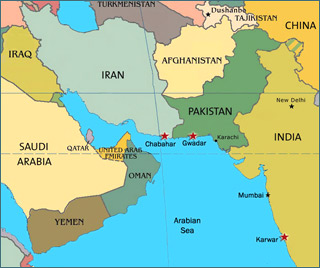
India, Iran, and the Chabahar Port Deal
Albert B. Wolf
 On Monday, May 23, the government of India announced that it would invest $500 million (USD) in the development of the Iranian port of Chabahar. The long-rumored deal was fostered in part by last year’s nuclear deal with Iran, the Joint Comprehensive Plan of Action (JCPOA). The “historic” deal not only opens a trade route through Afghanistan and into Central Asia that bypasses India’s enduring rival, Islamabad. It marks India’s emergence as a rising power in the Middle East.
On Monday, May 23, the government of India announced that it would invest $500 million (USD) in the development of the Iranian port of Chabahar. The long-rumored deal was fostered in part by last year’s nuclear deal with Iran, the Joint Comprehensive Plan of Action (JCPOA). The “historic” deal not only opens a trade route through Afghanistan and into Central Asia that bypasses India’s enduring rival, Islamabad. It marks India’s emergence as a rising power in the Middle East.
In the first visit by an Indian head of government to Iran in fifteen years, Narendra Modi said, “We want to link to the world, but connectivity among ourselves is also a priority. The corridor would spur unhindered flow of commerce throughout the region. Inflow of capital and technology could lead to new industrial infrastructure in Chabahar.” India is to begin paying Iran back for $6 billion in energy purchases (it made a payment of $750m last week). Other agreements were signed, including accords on banking, petrochemical and technological issues as well as anti-terrorism.
The deal kills four birds with one stone: it bypasses Pakistan, bests China’s Maritime Silk Road project, provides New Delhi with greater access to oil-rich Central Asia and lowers its dependence on energy sources in the Middle East. India’s investment has been welcomed in nearly all quarters in Tehran. Even with the gradual reduction in sanctions on the Islamic Republic, the heavy hand of the Pasdaran and the country’s out-of-date banking system have put off many potential foreign investors.
The Chabahar deal has at least three potential implications for India as well as the West: first, it represents a major shift in India’s attitude toward the Middle East; second, it has the potential to facilitate the oft-discussed U.S. “pivot” or “rebalancing” to Asia; and third, provide an additional enforcement mechanism for JCPOA.
Traditionally, India has had a policy of “non-interference” in the region. Since the Modi government came to power that stance has begun to change. India has had strong economic ties to the Gulf due to the presence of roughly over 7 million ex pats in the region. Half of those 7 million expats reside in Saudi Arabia. 70% of India’s crude oil comes from the Gulf; 85% of its natural gas comes from Qatar. India has had to take a higher profile in the region due to America’s declining energy dependence and fears associated with U.S. military withdrawal, as well as the rise of Islamic State of Iraq and al Sham (ISIS).
Unlike his predecessors, Modi has raised India’s profile in the Middle East. After Pakistan refused to supply troops for Saudi Arabia’s war in Yemen, King Salman signaled his displeasure by signing five agreements with New Delhi. These included understandings on intelligence sharing on terrorism financing and enhancing defense cooperation. The agreement with Iran is one of a series of initiatives pursued by the Modi government designed to increase India’s influence in the region.
A growing Indian presence in the Middle East may help to facilitate American retrenchment to East Asia. From its early days in office, the Obama Administration’s “pivot” and “rebalancing” efforts have been for naught: America remains entrenched in the Middle East. Despite having pulled out of Iraq in 2011, the Obama Administration has been sending advisors to both Iraq and Syria to assist with the fight against the Islamic State of Iraq and al Sham (ISIS). However, the Great Recession marked a watershed in international politics because it demonstrated the limits of America’s relative power and the growth of China’s influence. This has left some analysts to conclude that it is necessary for the U.S. to husband its resources, drawdown from the Middle East and counter-balance a rising (and inevitably dangerous) China. Whilerelative decline often motivates great powers to retrench or pull back from peripheral commitments, great powers are more likely to do so when they have a friendly powerready to take up the gauntlet. (Recently, the U.S. reached an agreement “in principle” allowing each country to use its others’ bases for “replenishment and repair,” while joint exercises with Japan were scheduled for later in the year near the South China Sea.)
The Chabahar port deal is consistent with speculation over India’s true motivations: it is searching for greater influence in the Indian Ocean. Abhijit Singh points out that India’s ability to project naval power has been rising. In addition to the recent agreement with the U.S., China has speculated India is fortifying the eastern Indian Ocean against Beijing’s submarines as part of a containment policy. India has not only been flexing its muscles in the eastern Indian Ocean region (IOR). The INS Vikramaditya, India’s newest aircraft carrier, visited Sri Lanka and the Maldives earlier this year, and has reached agreements to develop islands (and its naval strength) in the Maldives as well as the Seychelles. (It is important to note that analysts like Singh point out that for the time being, India’s combat capabilities are limited, dedicated to keeping sea lanes and chokepoints open.)
An obvious source of concern is a potential naval arms race between India and China. However, increasing Indian and Chinese interests in the Middle East and growing naval capabilities make both responsible stakeholders with respect to JCPOA, ensuring Iran remains a latent nuclear power. (NOTE: China was one of the signatories to the Iran nuclear deal.) Matthew Kroenig argues that great powers oppose nuclear proliferation among allies and adversaries alike. Proliferation places a ceiling on great powers’ ability to project military force, limits their ability to engage in coercive diplomacy, sets off chains of reactive proliferation, (further) destabilizes regions and undermines alliances. A nuclear Iran, even with a small arsenal along the lines of North Korea’s, would interfere with both states’ ability to project force in the region. Even if the security dilemma is exacerbated between China and India, their growing ability to project power compels each to keep the pressure on Iran to stay inside of its nuclear box.
The Chabahar port deal signals India’s growing influence in Central Asia, the Middle East and the IOR. It represents a shift in India’s traditional stance of non-interference in the Middle East and provides a potential partner to take up some of America’s commitments should Washington revisit militarily rebalancing to Asia in the future. Finally, it also has a greater stake in helping enforce JCPOA by deepening its relationship with Iran and expanding its naval footprint.





